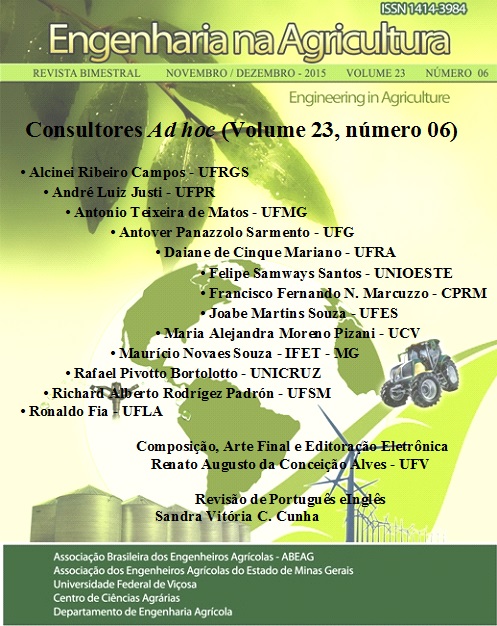MAPAS TEMÁTICOS DE COMPONENTES PRINCIPAIS PARA CARACTERIZAÇÃO DE PROPRIEDADES QUÍMICAS DO SOLO - DOI: 10.13083/1414-3984/reveng.v23n6p529-540
DOI:
https://doi.org/10.13083/reveng.v23i6.556Palavras-chave:
fertilidade do solo, análise multivariada, variabilidade espacialResumo
A agricultura na região Oeste do Paraná tem destaque por intensa atividade agrícola, na qual busca altas produtividades. A produtividade das áreas de cultivo está diretamente relacionada com a fertilidade. O uso intensivo do solo tende à acidificação e diminuição nos teores de nutrientes nele armazenados, o que, por consequência, limita também o desenvolvimento radicular, contribuindo para redução da produtividade. O presente trabalho foi desenvolvido com o intuito de investigar a relação entre as propriedades químicas do solo: acidez potencial, cálcio, magnésio, potássio, pH do solo, teor de matéria orgânica, soma de bases, capacidade de troca de cátions total e saturação por bases, na camada de 0,0 a 0,20 m. A exploração do solo na região se faz de forma intensiva com cultivos de soja, milho, trigo e feijão em sucessão de culturas. A amostragem de solo para análise das referidas variáveis foi georreferenciada (grid de 2 ha), sendo utilizadas técnicas de geoestatística e análise de componentes principais, com o intuito de identificar regiões que possuam maior acidez e deficiência de nutrientes que possam ser supridos por meio de calagem. Os resultados permitiram evidenciar a relação da acidez do solo com variáveis como cálcio e magnésio o que sugere a correção desses nutrientes nas regiões de elevada acidez. A classificação dos mapas em classes permite o direcionamento de ações em campo nas unidades com características similares, sendo importante para o trato localizado destas sub-regiões na área de estudo.Downloads
Downloads
Publicado
Como Citar
Edição
Seção
Licença
Autores que publicam nesta revista concordam com os seguintes termos:
O(s) autor(es) autoriza(m) a publicação do texto na da revista;
O(s) autor(es) garantem que a contribuição é original e inédita e que não está em processo de avaliação em outra(s) revista(s);
A revista não se responsabiliza pelas opiniões, ideias e conceitos emitidos nos textos, por serem de inteira responsabilidade de seu(s) autor(es);
É reservado aos editores o direito de proceder a ajustes textuais e de adequação às normas da publicação.
A partir da submissão, o autor estará cedendo integralmente seus direitos patrimoniais da obra à publicação, permanecendo detentor de seus direitos morais (autoria e identificação na obra) e de acordo com a Licença Creative Commons, CC BY-NC.








 Esta obra está licenciada com uma Licença
Esta obra está licenciada com uma Licença 